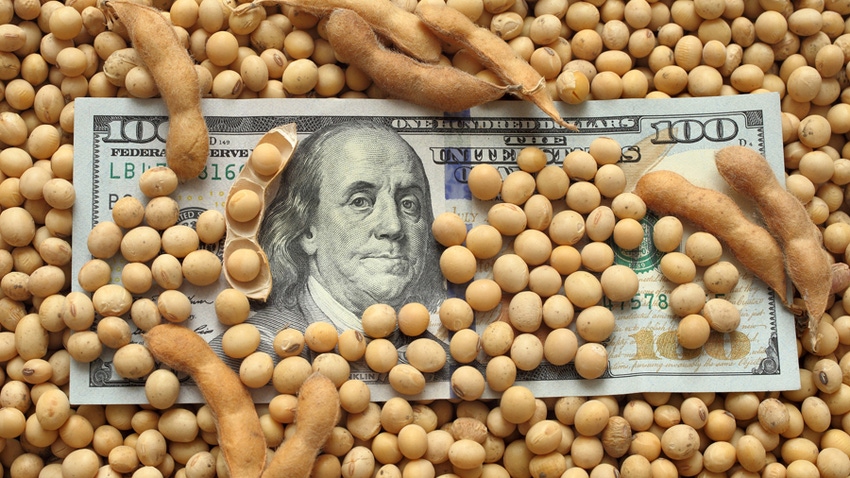
The July WASDE report is in the rearview mirror with plenty of surprises, as many in the trade expected. While the June Planted Acreage Report set the groundwork for a supportive environment for this bean market, it put pressure on corn. Today I’m going to focus more on soybean prices, as I think the discussion is one that needs to be highlighted.
When we saw the USDA print 83.5 for bean acres at the end of June, many thought bean prices would skyrocket. Given already tight carry-out numbers, such a low acreage number certainly puts pressure on the U.S. grower to raise a big yield to keep us from running out of soybeans this coming marketing year.
As we moved into the July WASDE, traders felt we’d see the new-crop carry come in somewhere around 200 million-bushels, but the USDA instead put carry at 300 mb. Given how poorly US new-crop exports have been running, the USDA likely had a good reason to slash export 125 mb like they did.
This sent prices reeling on Wednesday after the report was released. Given a bigger U.S. carry (by 50%) as well as a ballooning world balance-sheet, sellers were active at the first sign of a dent in the bullish US situation.
Fast-forward to Thursday. With a flash sale to Mexico as well as talk the Chinese were seeking U.S. beans, the market came back to life. While we lost 32 ½ cents off of November beans on Wednesday, we got that back and then some on Thursday.
With a close just shy of $13.70, November beans kept a recent uptrend in place and are within 80 cents of the life-of-contract high. This sort of price action sure makes many of us want to get bullish. We’ve all seen beans take off on a dollar rally when least expected, so selling after such a strong rebound isn’t always a popular thing to think about.
A different approach
My personal opinion when it comes to beans is to look at this rally a bit differently. Many producers around the Corn Belt are looking at close to $13.50 out of the field at current prices. How does $13.50 work for most producers? Given it’s only been a few weeks back on May 31 when we were $2.30 lower at $11.40, I can assure you today’s price works better than at levels over $2 lower.
My whole point here is to run the math. Work your numbers and see how good a price like $13.50 works for you at the type of yield you’re expecting. If it works, hedge off some risk.
How we manage that risk is up to the individual producer, but for me, I want to keep my flexibility. I like buying a put option or a put spread-and in the case where a producer is willing to put a ceiling on prices, sell a call or two up at $15 or so to cheapen the cost. Another way to latch onto some of the profit margins in a flexible manner would be to sell beans as an HTA or fall delivery, then buy a call spread. This will give the producer a chance to participate should the market rally higher after we sell some of these beans.
I know it’s tough to market no matter where prices are. However, I’d be cautious as to turn my nose up at prices this close to $14 at a time when world stocks are growing so rapidly.

I hope you get plenty of rain these next few weeks --good luck with the rest of the growing season.
Feel free to reach out to me or anyone on the AgMarket team. We’d love to hear from you.
Reach Matt Bennett at 815-665-0462 or [email protected].
The risk of loss in trading futures and/or options is substantial and each investor and/or trader must consider whether this is a suitable investment. AgMarket.Net is the Farm Division of John Stewart and Associates (JSA) based out of St Joe, MO and all futures and options trades are cleared through ADMIS in Chicago IL. This material has been prepared by an agent of JSA or a third party and is, or is in the nature of, a solicitation. By accepting this communication, you agree that you are an experienced user of the futures markets, capable of making independent trading decisions, and agree that you are not, and will not, rely solely on this communication in making trading decisions. Past performance, whether actual or indicated by simulated historical tests of strategies, is not indicative of future results. Trading information and advice is based on information taken from 3rd party sources that are believed to be reliable. We do not guarantee that such information is accurate or complete and it should not be relied upon as such. Trading advice reflects our good faith judgment at a specific time and is subject to change without notice. There is no guarantee that the advice we give will result in profitable trades. The services provided by JSA may not be available in all jurisdictions. It is possible that the country in which you are a resident prohibits us from opening and maintaining an account for you.
The opinions of the author are not necessarily those of Farm Futures or Farm Progress.
About the Author(s)
You May Also Like






